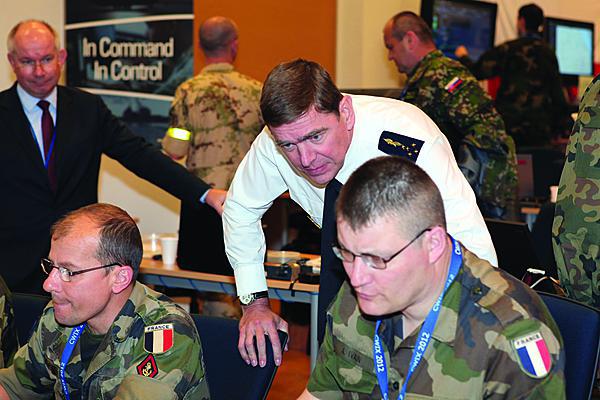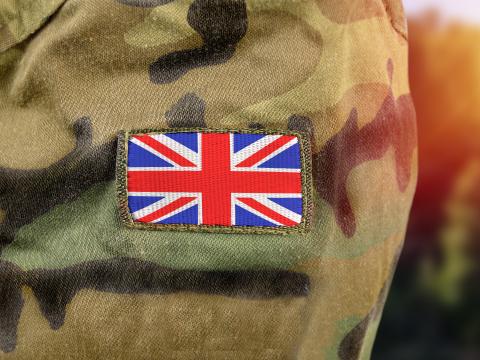The Tactical Edge Sees Data Interoperability
Different command and control systems are closer to enjoying Web interoperability as a result of experiments performed in coalition exercises. Protocols and processes developed by defense information technology experts can enable data to be exchanged among the services as well as in coalition operations.
A new message exchange framework offers potential across department and coalition assets.
Different command and control systems are closer to enjoying Web interoperability as a result of experiments performed in coalition exercises. Protocols and processes developed by defense information technology experts can enable data to be exchanged among the services as well as in coalition operations.
The Tactical Edge Data Solutions (TEDS) joint capability technology demonstration (JCTD) and Coalition Warfare Project produced repeatable processes and artifacts that reduce the time, effort and cost associated with developing new eXtensible Markup Language (XML)-based data exchanges between disparate information technology systems. The JCTD, which was sponsored by the Joint Staff J-6 Data and Services Division, generated significant results during Coalition Warrior Interoperability Exercise (CWIX) 12, which was conducted June 4-21, 2012, at multiple sites in the United States and Europe. CWIX 12 included demonstrations involving the U.S. Army Command Post of the Future, the U.S. Marine Corps Joint Tactical Common Operational Picture Workstation (JTCW) and coalition command and control (C2) systems. The result was a deployable solution that is shareable across the U.S. Defense Department and available for reuse by coalition partners.
The TEDS JCTD demonstrated the operational effectiveness of an emerging XML data standard called C2 Core. This standard focuses on machine-to-machine exchange of C2 data and was designed to facilitate data sharing within the C2 capability area through common vocabulary definitions, data component representations and message structures. It generally is applicable for adoption in software applications and C2 systems requiring XML-based messaging. While previous exchange strategies have been successful in specific C2 arenas, C2 Core is the first recognized common core supporting Defense Department net-centric data strategy goals for enabling data to be understandable and interoperable. C2 Core has been submitted to the Defense Information Technology Standards Registry as an emerging standard and has been approved for limited implementation by the Data and Services Steering Committee.
Beginning in 2010, the TEDS initial operational demonstration had produced remarkable results in the areas of reduced development time and time to market as well as in cost avoidance. A position report was exchanged between the command post, the JTCW and Joint Deployable Analysis Team’s (JDAT’s) C2 node. The Army and Marine Corps initially worked together to develop a C2 Core conformant information exchange specification (IES). The requirements and agreement documented in the IES allowed the Army to take the lead in developing a single Web service that later was implemented by both the Marine Corps and the Army in their service-oriented architecture (SOA) stacks supporting C2 systems. The ability of the Army to develop a Web service that both participants could use resulted in cost avoidance, because the initial project plan had budgeted for the Marine Corps to develop its own Web service.
Subsequent to the development of the TEDS IES and Web service, the JDAT used both artifacts to create a consuming Web service in only two weeks. The JDAT work represents a significant reduction in implementation time when compared to the three to four months required to develop the initial position report IES and Web service. This demonstration successfully proved that using standardized XML design rules along with a limited core vocabulary and Web services could expedite information exchanges between existing C2 systems.
The testing continued and TEDS, which also included five coalition partners from Allied Command Transformation—Canada, Poland, France, the Netherlands and the then-NATO Consultation, Command and Control Agency—participated in CWIX 11. The CWIX demonstration incorporated the products from the 2010 event plus two additional information exchange requirements: enemy situation report and significant activity report. The success of this event demonstrated the ability of the processes and concepts used in the 2010 demonstration to scale beyond a single data exchange and three exchange partners.
In both events, the participants constructed a simple Web service using open standards to function as an interface between their existing C2 systems. These services were used to translate proprietary system information into a TEDS IES that could be shared with all participants. The development time for creating a consuming Web service mediated to the TEDS IES was a matter of weeks, versus months, and it required only minimal training on the C2 Core XML design rules because of the developer’s familiarity with XML. More important, TEDS took advantage of the Defense Department’s collaboration capabilities of central repositories, such as the Metadata Registry, software.forge.mil and All Partners Access Network. These were used to publish XML data and software source code and documentation, respectively. As a result, all products created during the TEDS JCTD now are published to registries in compliance with open-source development standards.
In the CWIX 11 demonstration, France created its own Web service to its national-level C2 system and published information in C2 Core conformant XML, which then was mediated by the U.S. Army and Marine Corps. Army and Marine Corps participants consumed France’s information into their battalion-level C2 systems and used it to display content on a graphical map. Because the Army and Marines already had a working Web service, they required minimal development to understand and use France’s data, which now was mediated to the TEDS IES. This exercise showed reduced costs and time to implement existing IESs and Web services subsequent to their initial development.
This highlights another vital concept in TEDS and Defense Department efforts to improve net-enabled operations, as well as a key tenet of SOA standards—reuse. By leveraging past work and previous design successes, program managers can shorten design time and reduce costs in their efforts to create new information exchanges with other Defense Department and coalition systems. The challenge has been to create a method of sharing program successes and activities that allows the community to find the capabilities relevant to its own requirements. With standardized global Defense Department registries, the knowledge barrier can be breached, equipping program managers to capitalize on related technology successes while avoiding the ongoing problem of reinventing the wheel and wasting resources.
The final operational demonstration for TEDS was conducted at CWIX 12. Finland joined as a participant, and three additional information exchange requirements were added: observed position report, air track and tactical graphics. In addition to the new messages, French maritime and NATO intelligence, surveillance and reconnaissance systems were included in the architecture. CWIX 12 provided partners with exposure to the latest version of C2 Core and the opportunity to gain additional experience with TEDS technologies.
TEDS used the latest Web service standards, combined with C2 Core conformant information exchanges, to implement design principles of a SOA. This SOA framework provides the ability to link existing C2 systems in an ad hoc manner that greatly reduces the expensive and time-consuming development cycles normally associated with building complex mediation solutions between proprietary systems. David O’Neill, operational manager for the JCTD, explains, “If we can deliver a reliable, flexible and interoperable solution to help meet warfighters’ data needs while increasing their available knowledge to support C2 decision making, then we will have provided something of great value to the Defense Department and our coalition partners.”
The ability to meet requirements of lower bandwidth and disconnected environments to improve interoperability, vertically as well as horizontally, becomes more challenging closer to the tactical edge. Accordingly, TEDS targeted battalion-level information exchanges for the first increment with the goal of expanding each additional increment to include strategic as well as tactical information exchanges.
The revolution in C2 information management presented by TEDS must meet leader-centric data requirements while overcoming current Defense Department interoperability challenges. Leaders depend on seamless information exchange among networked participants, which in turn depends on the ability of machines to correctly interpret data exchanged across systems or organizational boundaries. Data interoperability problems are caused by different definitions, names and structures used to represent information. The constant emergence of new data standards so far has proved unavoidable despite the Defense Department’s extensive library of tactical datalink and information exchange models. Attempts to resolve the differences between various standards results in what is called the “N-squared problem”—each system or node in the enterprise must mediate its differences with every other node. This puts a burden on human engineers to be an expert on their node and at least one other as they seek to fit their information into someone else’s concepts. Apply this requirement to legacy and emerging systems, and it rapidly becomes unmanageable. It is difficult to train enough people on all the systems. The challenge is not in creating the model but in community learning and interpretation.
To address these challenges, the Defense Department has moved toward communities of interest (COIs). The COI concept in the department’s net-centric data strategy recognizes the infeasibility of a single large data model and postulates that a single large model is not possible for everyone. As an alternative, several smaller models can be used for individual COIs.
COIs can have varying degrees of overlap with each other, and this overlap becomes the basis for a universal or core model. For example, the C2 Core represents the most common C2 terms among the communities falling under its umbrella. Each COI then develops specific definitions within its subject area unique to its needs. At the highest level, the Defense Department has developed a simple umbrella model that unites the common cores, called Universal Core. The Universal Core and the C2 Core are the first attempts to realize the universal/common core vocabulary concept.
These cores are not designed to replace existing system standards but instead to function as a common method of mediation between systems. So, the C2 Core is called a message exchange framework. It is a tool for passing information among systems, but each system may use the information however it sees fit once ingested. This approach seeks to minimize the effect on both legacy and new systems alike, allowing programs to tailor their information exchanges at the software level outside of their existing architectures. The end vision is an enterprise of disparate systems each publishing their data using commonly defined interfaces and common message exchanges. Program managers and their developers would be able to share data with other systems output to their system in a true realization of a SOA, creating new functionality from existing capabilities along with shared understanding and situational awareness.
TEDS successfully capitalized on the latest efforts to realize the net-centric data strategy. This paradigm of information sharing using flexible semantics with structured XML design rules represents the future of rapid interoperability among previously disparate systems. The TEDS JCTD successfully demonstrated the capability at battalion level, and some initial efforts to bring these capabilities to low bandwidth variable message format transmissions also have proved successful. As Defense Department services and agencies embrace open-source design standards, these technologies will continue to gain functionality and a wider base of users. Final realization of these capabilities will be required to overcome the challenges brought on by rapid acquisition of information technology and increasing connectivity within the Defense Department and future coalitions.
Capt. Mike Stephens, USAF, formerly the deputy technical manager for the TEDS JCTD while assigned to the Joint Staff J-6 Data and Services Division, now is assigned to the 8th Air Force 8th Communications Support Squadron. Frank Klucznik is a senior research scientist working for the Georgia Tech Research Institute.




Comments